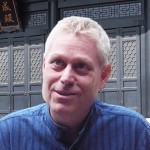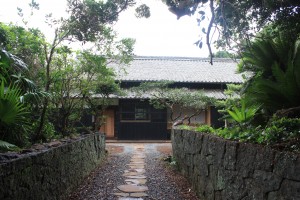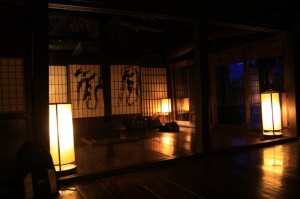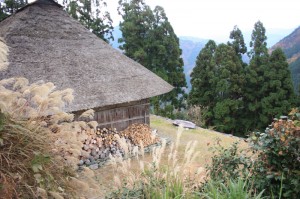サイトオープン記念特別インタビュー アレックス・カーさん
Special Interview with Mr. Alex Kerr Memorial site open
English here.
取材場所:湯島聖堂(東京都文京区湯島1-4-25)
Alex Kerr [アレックス・カー]

米国メリーランド州生まれ。1964年初来日。少年期に体験した日本の美しさと失われゆく現状を国内外に訴え、次代へ残すべく、文化芸術活動の推進、講演、執筆活動など幅広く行い、日本各地に残る美しい風景と文化を守り伝える事業を推進。東祖谷に残る古民家を再生、活用する新しいもてなしの形をプロデュース。著作に「美しき日本の残像」(1994年新潮学芸賞受賞作)、「犬と鬼」などがある。
コミュニティのリサイクルが田舎を救う

講演を行うと、数年前から誰も住んでいない古民家があるとか、年寄りだけで今後が決まっていない古民家があるとか、様々な相談を受けます。自分で住もうとは思っていないけれど、もったいないという気持ちはあるんですね。日本の田舎は高齢化、過疎化が進んでどうしようもない状況です。Uターンと言うけれど、結局、進まない。うまくいかない。
世界を見渡せば、参考になる地域があります。例えば、イギリスのコッツウォルズです。きれいな田園風景、かわいい建物や村。ロンドンから1.5時間という距離にすばらしい風景が残っています。元の住民の9割は出て行ってしまって、住んでいるのは、ロンドンのシティで働いている人やデザイナーなどです。

新しい住民は、コッツウォルズの風景が好きだからとても大事にしていて、変な建物を建てない、建てさせない。見た目は昔のままですが、中身は現代なのです。又、イギリスのレイクカントリーも別荘地として新しい住民によるコミュニティがあります。外部の人が入ってきて、新しく生まれ変わった田舎町です。
美しい田舎の風景が現代に残っているのは、建物だけではなく、コミュニティのリサイクルがあるからなのです。日本の田舎を救う方法は、多分、この方法しかない。若い人達に、ただ帰って来いと言っても無理。実際、祖谷でも、名古屋や大阪から来ている。こういうのがこれからの主流になると思います。僕の活動は、田舎のリサイクルだと思っています。
建物の改修は全体の1割
先祖から受け継いだ家を何とかしたいのだけど、どうしたらよいのかわからないという人も多いですね。自治体の場合もあります。建物そのものは立派だけど、線路の隣に建っていたり、隣に工場ができてしまったりと、周囲の景色があまりにも変わってしまった場合には、移築を勧めることもあります。
僕は、古民家を捨てることは絶対にしませんが、その場所では無理ということもあるのです。その建物だけをきれいにしても、周りに遊ぶところがなかったり、泊まるところがなかったりする場合は、手間とお金をかけて建物をきれいにしても残念な結果になってしまう。建物だけ直せばいいという単純な話ではないのです。
歴史、立地、周辺環境、地元との話し合い、お客さんのニーズ、観光のPR、演出、庭が良い、宿泊が良いなど、色々な要素があるから、全体を考えて改修しないと失敗します。予算もあります。少ない予算で何ができるのか、補助金は出ないのか、と考えます。建物の改修というのは、プロジェクト全体の1割程度です。
古民家オーナーは「景観オーナー」
私が活動を始めた頃は、古民家を自分で探して住んでいる人は外国人ばかりでした。ここ数年、日本人も興味を持つようになり、若い人達が古民家に住むようになってきました。まだ立派な古民家が残っている地域があり、一軒でも多く残したいと思います。残っているものがますます大切で貴重なのです。
日本の田舎がだめになったのは、変な工事をやってきたから。これから田舎で何かをやろうとする時は、自分の商売だけではなく、地元や自治体との話し合いも積極的にやりましょう。意外と一人一人の力が大きいのです。古民家オーナーは、景観オーナーだと思いましょう。
最新プロジェクトの紹介
僕の始まりは、徳島県の祖谷です。最初の頃は、周辺の人は親切だけれど、積極的ではなかった。でも、祖谷にお客さんが来るようなって、積極的になってきました。

NPO法人遽ェ庵トラストでは、数年前から活動の輪を広げ、祖谷全体でプロジェクトを行っています。現在、3軒の改修を終え、あと4軒ほど改修する計画です。改修後は、私たちのNPOが管理することになっています。今までは夢みたいな話だと思っていたけれど、実現できることになって非常にうれしいです。
長崎沖の離島、小値賀島では、既に5軒改修しました。ああいう所は、チャレンジなんです。東京から行くとしたら、パリに行ける。あんな辺鄙な所に、どうやってお客さんを呼ぶか、というチャレンジでした。でも、今年の夏はお客さんがいっぱい。実際にきてくれるとうれしいですね。小値賀島がうまくいったポイントのひとつは、無駄な公共事業がなかったから。隠れキリシタンの歴史があり、教会等の建物がきれいに残っています。

それから、快適な宿泊場所を提供することができたこともポイントです。この部分が僕の仕事でした。また、地元で管理をしてくれるグループがないと成り立たないのですが、おぢかアイランドツーリズムというパワフルなグループがあり、PRしてくれました。
他には、岡山県の山奥にある新庄村があります。昔の宿場町で、桜の枝が路の上に伸びていて、なんとも言えないかわいらしい村です。まだ調査段階ですが、再生を図るプロジェクトを開始しました。
遽ェ庵の活動を広げたい
日本の国もそうだし、地方も財政パンク。田舎は人口も減って危機的問題を抱えています。東日本大震災後の東北地方では、地震で被災した古民家を国の費用で一律に解体・処分しているという話を聞きました。そこまで無関心。責任があるはずの文化庁なども無関心です。

ただ、暗い中だけれども、一生懸命活動している民間団体があったり、意欲のある若い人達が増えたりしています。積極的な自治体もありますので、そういう人達にできるだけ協力したいと思っています。僕は、アドバイスやプロデュースはしますが、地元の大工さんや建築家と一緒にやることにしています。僕がいなくても出来るようになるために、共同作業がいいと思っています。遽ェ庵で始まった活動を全国に広げていきたいというのが夢ですね。
ENGLISH
Special Feature
Cominka People Special Opening Interview Alex Kerr
Interview conducted at Yushima Temple (1-4-25, Yushima, Bunkyo, Tokyo)
Alex Kerr
Kerr was born in Maryland and came to Japan for the first time in 1964. Through cultural activities, lectures and writings, he is very active in promoting beautiful Japanese landscape and culture, which are still remaining, yet being lost. Beauty of Japan he saw in his childhood left a lasting impression on him, driving him to appeal both domestically and internationally the current situation of cominka and the necessity to take action in order to pass it onto the next generation. He produced a new form of hospitality by revitalizing and utilizing cominka in Higashi Iya. His books include “Lost Japan” (awarded Sincho Gakugeisho in 1994) and “Dogs and Demons”.
Recycling Community Saves the Countryside
When I go around giving lectures, I get many different kinds of consultations like “there’s cominka that nobody’s living in for years” or “there’s cominka which the old owner doesn’t know what to do in the future”. They don’t want to live in those cominkas themselves, but they do feel it shouldn’t just be demolished. With aging and depopulation, Japanese countryside is completely stuck. They talk about U-turn but that’s not happening.
In other parts of the world, there are areas that we can learn from. In Cotswold in the UK for example, you find beautiful countryside landscapes and lovely villages. In just one and half hour away from London, wonderful landscape is still there. 90% of original residents have already left and it’s people like businessmen from the City and designers living there now. Those new residents do care much about landscape of Cotswold because they love it. So they don’t build – or don’t allow anybody else to build – buildings that don’t go with Cotswold landscape. The area looks very traditional and unchanged, but inside, it’s contemporary. Lake District in the UK is another example of a countryside given new life. It also has community of new residents as a resort.
It is thanks to this recycling – not only of buildings, but of community – that beautiful countryside landscape is still there today. I believe this is the only method to save countryside of Japan. Just asking young people to come back doesn’t work. In Iya, too, residents come from Nagoya, Osaka. I think this will become the mainstream. I believe my activity is about recycling of countryside.
The Actual Refurbishment Accounts Only 10% of the Whole Project
There are many people who want to do something to save the house they inherited from their ancestors, but don’t know what to do. Sometimes it’s a local government that’s having this problem. In some cases the building itself is magnificent and in good condition, but the problem is something like railway goes right next to it now, or there’s factory right next to it – the environment and the landscape have just changed too much. In those cases I sometimes recommend moving of the building.
I never abandon a cominka. But in some cases it just doesn’t work on the current location. Even if you refurbish or clean one building, without places to go or places to stay, time and money put on the building will not bring a good result. It’s not as simple as you just need to fix your building.
History, location, environment, local community, client’s needs, sightseeing promotion, presentation, garden, hotel – without thinking of the whole, refurbishment doesn’t work, as there are many different elements. You have to think about things like “what can be done in the limited budget?”, “Is there any grant available?”. The actual refurbishment of the building constitutes only about 10% of the whole project.
Cominka Owner is a Landscape Owner.
When I started working on cominka, it was almost only foreign people that looked for a cominka themselves and lived in it. It’s only recent years that Japanese people started to be interested in cominka and young people actually living in it. There still are areas where you can find fine cominkas and I want to preserve them as many as possible. Remaining ones are becoming more and more precious these days.
What ruined Japanese countryside is pointless construction projects. Now, if you want to do something in countryside, let’s make sure that we actively talk to local people, local government, rather than thinking only about your own business. Each individual can make difference. I believe cominka owner is a landscape owner.
Latest Projects
Iya in Tokushima is where I started. At the beginning, people were very kind but not actively involved. But as Iya was getting more and more visitors, they are becoming more active. In recent years NPO Chiiori Trust has expanded its activity, now working in all Iya. We have completed refurbishment of 3 buildings and we have 4 more to go. After refurbishment we are to manage them. It was all like just a dream, but I’m really happy it’s coming true.
We have already refurbished 5 at Ojika Island of Nagasaki. Place like that is a big challenge. If you are to go there from Tokyo, you can go to Paris with same amount of time. It was a challenge of how we can get tourists come to such a remote place. But we did get a lot of tourist this summer. It’s so nice to see tourists actually coming. One of the reasons Ojika was successful is they didn’t have those pointless public construction projects. The island has history of secret Christianity and buildings like church are still there in a good condition. Being able to provide comfortable accommodation was another important element, and I was responsible for that. Also, an organization that does management there was essential, and for this part, a powerful group called Ojika Island Tourism helped us in PR.
Shinjo-son in Okayama is another latest project. It’s a lovely little village which used to be an inn town, with cherry blossom trees overlooking a road. We are still in a research phase, but a project of revitalization has started.
Spreading Chiiori Activities
Local governments and national alike, they are in financial dysfunction. Countryside is suffering depopulation. I heard that in Tohoku after the Great East Japan Earthquake, national government is paying for deconstruction and disposition of damaged cominka. That’s how much they are indifferent. Institutions like Agency for Cultural Affairs, which should be more engaged, are indifferent too.
But although the situation is grim, we are seeing more and more dedicated grass rooted organizations and active young people. There are some local government which are receptive to those kind of activities, so I’m seeking to support them. I do produce and give advice, but I work with local carpenters and architects, as I believe collaboration is a better method in order to eventually make them independent and hand things off. My dream is to see Chiiori activities spread all over Japan.


